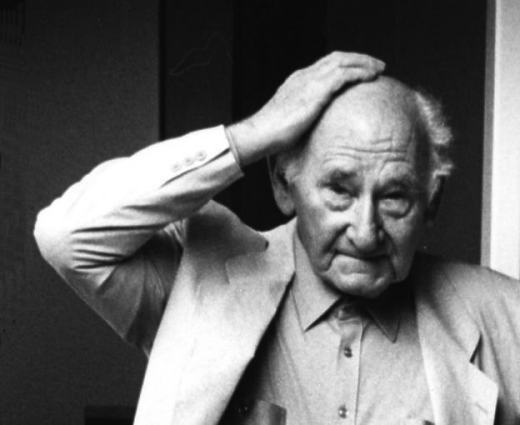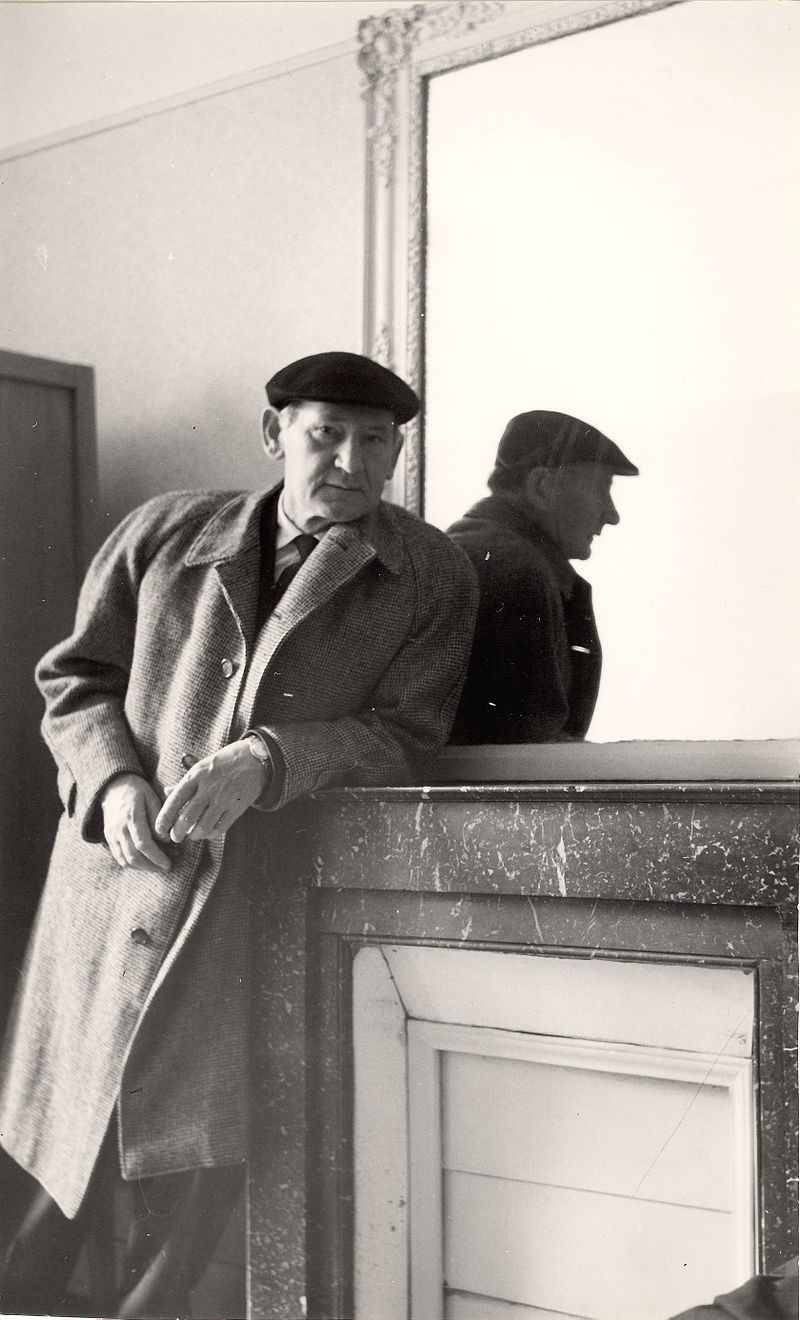<Back to Index>
- Graphic Designer Todd Radom, 1964
- Graphic Designer Paul Rand (Peretz Rosenbaum), 1914
- Graphic Designer, Photographer and Painter Anton Stankowski, 1906
PAGE SPONSOR

Todd Radom (born 1964 in New York, New York) is a graphic designer who is responsible for many of the logos used by American sports teams. His designs include the current logos of the Washington Nationals and Anaheim Angels. Among his many other creations were the logos for the Super Bowl, and the Basketball Hall of Fame.
Radom's style is dominated by two elements: his distinctive use of typography and his inclusion of classic visual elements.
A 1986 graduate of the School of Visual Arts, Radom has designed hundreds of book covers and helped develop corporate identities for non - sports clients.
He currently works and lives in Katonah, New York.

Paul Rand (born Peretz Rosenbaum, (August 15, 1914 - November 26, 1996) was an American graphic designer, best known for his corporate logo designs, including the logos for IBM, UPS, Enron, Westinghouse, ABC, and Steve Jobs’ NeXT. He was one of the originators of the Swiss Style of graphic design.
Rand was educated at the Pratt Institute (1929 – 1932), Parsons The New School for Design (1932 – 33), and the Art Students League (1933 – 1934). From 1956 to 1969, and beginning again in 1974, Rand taught design at Yale University in New Haven, Connecticut. Rand was inducted into the New York Art Directors Club Hall of Fame in 1972. Rand died of cancer in 1996 in Norwalk, Connecticut. He is buried in Beth El Cemetery.
Paul Rand was born on August 15, 1914 in Brooklyn, New York. He embraced design at a very young age, painting signs for his father’s grocery store as well as for school events at P.S. 109.
Rand’s father did not believe art could provide his son with a
sufficient livelihood, and so he required Paul to attend Manhattan’s
Harren High School while taking night classes at the Pratt Institute,
Rand was largely “self - taught as a designer, learning about the works
of Cassandre and Moholy - Nagy from European magazines such as [Gebrauchsgraphik].”
His career began with humble assignments, starting with a part time position creating stock images for a syndicate that supplied graphics to various newspapers and magazines. Between his class assignments and his work, Rand was able to amass a fairly large portfolio, largely influenced by the German advertising style Sachplakat (object poster) as well as the works of Gustav Jensen. It was around this time that he decided to camouflage (and abbreviate) the overtly Jewish identity telegraphed by ‘Peretz Rosenbaum,’ shortening his forename to ‘Paul’ and taking ‘Rand’ from an uncle to form his new surname. Morris Wyszogrod, a friend and associate of Rand, noted that “he figured that ‘Paul Rand,’ four letters here, four letters there, would create a nice symbol. So he became Paul Rand." Roy R. Behrens notes the importance of this new title: “Rand’s new persona, which served as the brand name for his many accomplishments, was the first corporate identity he created, and it may also eventually prove to be the most enduring." Indeed, Rand was rapidly moving into the forefront of his profession. In his early twenties he was producing work that began to garner international acclaim, notably his designs on the covers of Direction magazine, which Rand produced for no fee in exchange for full artistic freedom. Among the accolades Rand received were those of Laszlo Moholy - Nagy:
| “ | Among these young Americans it seems to be that Paul Rand is one of the best and most capable [. . .] He is a painter, lecturer, industrial designer, [and] advertising artist who draws his knowledge and creativeness from the resources of this country. He is an idealist and a realist, using the language of the poet and business man. He thinks in terms of need and function. He is able to analyze his problems but his fantasy is boundless. | ” |
The reputation Rand so rapidly amassed in his prodigious twenties never dissipated; rather, it only managed to increase through the years as the designer’s influential works and writings firmly established him as the éminence grise of his profession.
Although Rand was most famous for the corporate logos he created in the 1950s and 1960s, his early work in page design was the initial source of his reputation. In 1936, Rand was given the job of setting the page layout for an Apparel Arts magazine anniversary issue. “His remarkable talent for transforming mundane photographs into dynamic compositions, which [. . .] gave editorial weight to the page” earned Rand a full time job, as well as an offer to take over as art director for the Esquire - Coronet magazines. Initially, Rand refused this offer, claiming that he was not yet at the level the job required, but a year later he decided to go ahead with it, taking over responsibility for Esquire’s fashion pages at the young age of twenty - three.
The cover art for Direction magazine proved to be an important step in the development of the “Paul Rand look” that was not as yet fully developed. The December 1940 cover, which uses barbed wire to present the magazine as both a war - torn gift and a crucifix, is indicative of the artistic freedom Rand enjoyed at Direction; in Thoughts on Design Rand notes that it “is significant that the crucifix, aside from its religious implications, is a demonstration of pure plastic form as well . . . a perfect union of the aggressive vertical (male) and the passive horizontal (female)."
Rand’s most widely known contributions to design are his corporate identities, many of which are still in use. IBM, ABC, Cummins Engine, UPS, and the now - infamous Enron, among many others, owe Rand their graphical heritage. One of his strengths, as Moholy - Nagy pointed out,
was his ability as a salesman to explain the needs his identities would
address for the corporation. According to graphic designer Louis
Danziger:
| “ | He almost singlehandedly convinced business that design was an effective tool. [. . .] Anyone designing in the 1950s and 1960s owed much to Rand, who largely made it possible for us to work. He more than anyone else made the profession reputable. We went from being commercial artists to being graphic designers largely on his merits. | ” |
Rand’s defining corporate identity was his IBM logo in 1956, which as Mark Favermann notes “was not just an identity but a basic design philosophy that permeated corporate consciousness and public awareness." The logo was modified by Rand in 1960. The striped logo was created in 1972. The stripes were introduced as a half - toning technique to make the IBM mark slightly less heavy and more dynamic. Two variations of the "striped" logo were designed; one with eight stripes, one with thirteen stripes. The bolder mark with eight stripes was intended as the company's default logo, while the more delicate thirteen stripe version was used for situations where a more refined look was required, such as IBM executive stationery and business cards. Rand also designed packaging, marketing materials and assorted communications for IBM from the late 1950s until the late 1990s, including the well known Eye - Bee - M poster. Ford appointed Rand in the 1960s to redesign their corporate logo, but afterwards chose not to use his modernized design.
Although his logos may be interpreted as simplistic, Rand was quick to point out in A Designer’s Art that “ideas do not need to be esoteric to be original or exciting."
His American Broadcasting Company trademark, created in 1961, then used
by ABC-TV in the fall of 1962, epitomizes that ideal of minimalism
while proving Rand’s point that a logo “cannot survive unless it is
designed with the utmost simplicity and restraint.”
Rand remained vital as he aged, continuing to produce important
corporate identities into the eighties and nineties with a rumored
$100,000 price per single solution. The most notable of his later works
was his collaboration with Steve Jobs for the NeXT Computer
corporate identity; Rand’s simple black box breaks the company name
into two lines, producing a visual harmony that endeared the logogram to
Jobs. Steve Jobs was pleased: just prior to Rand’s death in 1996, his
former client labelled him, simply, “the greatest living graphic
designer.”
Though Rand was a recluse in his creative process, doing the vast majority of the design load despite having a large staff at varying points in his career, he was very interested in producing books of theory to illuminate his philosophies. László Moholy - Nagy may have incited Rand’s zeal for knowledge when he asked his colleague if he read art criticism at their first meeting. Rand said no, prompting Moholy - Nagy to reply “Pity.” Heller elaborates on this meeting's impact, noting that, “from that moment on, Rand devoured books by the leading philosophers on art, including Roger Fry, Alfred North Whitehead and John Dewey." These theoreticians would have a lasting impression on Rand’s work; in a 1995 interview with Michael Kroeger discussing, among other topics, the importance of Dewey’s Art as Experience, Rand elaborates on Dewey’s appeal:
| “ | [. . . Art as Experience] deals with everything -- there is no subject he does not deal with. That is why it will take you one hundred years to read this book. Even today's philosophers talk about it[.] [E]very time you open this book you find good things. I mean the philosophers say this, not just me. You read this, then when you open this up next year, that you read something new. | ” |
Dewey is an important source for Rand’s underlying sentiment in graphic design; on page one of Rand’s groundbreaking Thoughts on Design,
the author begins drawing lines from Dewey’s philosophy to the need for
“functional - aesthetic perfection” in modern art. Among the ideas Rand
pushed in Thoughts on Design was the practice of creating graphic
works capable of retaining recognizable quality even after being
blurred or mutilated, a test Rand routinely performed on his corporate
identities.
During Rand's later career, he became increasingly agitated about the rise of postmodernist theory and aesthetic in design. In 1992, Rand resigned his position at Yale in protest of the appointment of postmodern and feminist designer Sheila Levrant de Bretteville, and convinced his colleague, Armin Hofmann to do the same. In justification of his resignation, Rand penned the article Confusion and Chaos: The Seduction of Contemporary Graphic Design where he denounced the postmodern movement as "faddish and frivolous" and "harbor[ing] its own built-in boredom".
Despite the importance graphic designers place on his book Thoughts on Design, subsequent works such as From Lascaux to Brooklyn (1996), compounded accusations of Rand being “reactionary and hostile to new ideas about design.” Steven Heller
defends Rand’s later ideas, calling the designer “an enemy of
mediocrity, a radical modernist” while Favermann considers the period
one of “a reactionary, angry old man.” Regardless of this dispute,
Rand’s contribution to modern graphic design theory in total is widely
considered intrinsic to the profession’s development.
The core ideology that drove Rand’s career, and hence his lasting influence, was the modernist philosophy he so revered. He celebrated the works of artists from Paul Cézanne to Jan Tschichold, and constantly attempted to draw the connections between their creative output and significant applications in graphic design. In A Designer’s Art Rand clearly demonstrates his appreciation for the underlying connections:
| “ | From Impressionism to Pop Art, the commonplace and even the comic strip have become ingredients for the artist’s cauldron. What Cézanne did with apples, Picasso with guitars, Léger with machines, Schwitters with rubbish, and Duchamp with urinals makes it clear that revelation does not depend upon grandiose concepts. The problem of the artist is to defamiliarize the ordinary. | ” |
This idea of “defamiliarizing the ordinary” (or "making the familiar
strange," a strategy commonly credited to Russian Formalist critic Viktor Shklovsky)
played an important part in Rand’s design choices. Working with
manufacturers provided him the challenge of utilizing his corporate
identities to create “lively and original” packaging for mundane items, such as light bulbs for Westinghouse.


Anton Stankowski (June 18, 1906 - December 11, 1998) was a German graphic designer, photographer and painter. He developed an original Theory of Design and pioneered Constructive Graphic Art. Typical Stankowski designs attempt to illustrate processes or behaviors rather than objects. Such experiments resulted in the use of fractal - like structures long before their popularization by Benoît Mandelbrot in 1975.
Anton Stankowski was born in Gelsenkirchen, Westphalia. Before embarking on the profession of graphic designer, Stankowski worked as a decorator and church painter. In 1927 he attended the Folkwang Schule with fellow photographer, Max Burchartz.
Stankowski's work is noted for straddling the camps of fine and applied arts by synthesizing information and creative impulse. He was inspired by the abstract paintings of Piet Mondrian, Theo van Doesburg, Malevich and Kandinsky. Stankowski advocated graphic design as a field of pictorial creation that requires collaboration with free artists and scientists.
Despite producing many unique examples of concrete art and photographics, Stankowski is best known for designing the simple trademark of the Deutsche Bank.
By 1980, Stankowski had produced a volume of trademarks for clients in Germany and Switzerland. In 1983, he established the Stankowski Foundation to award others for bridging the domains of fine and applied art. Following his death in December 1998, the German Artist Federation awarded Anton Stankowski the honorary Harry Graf Kessler Award for his life work.